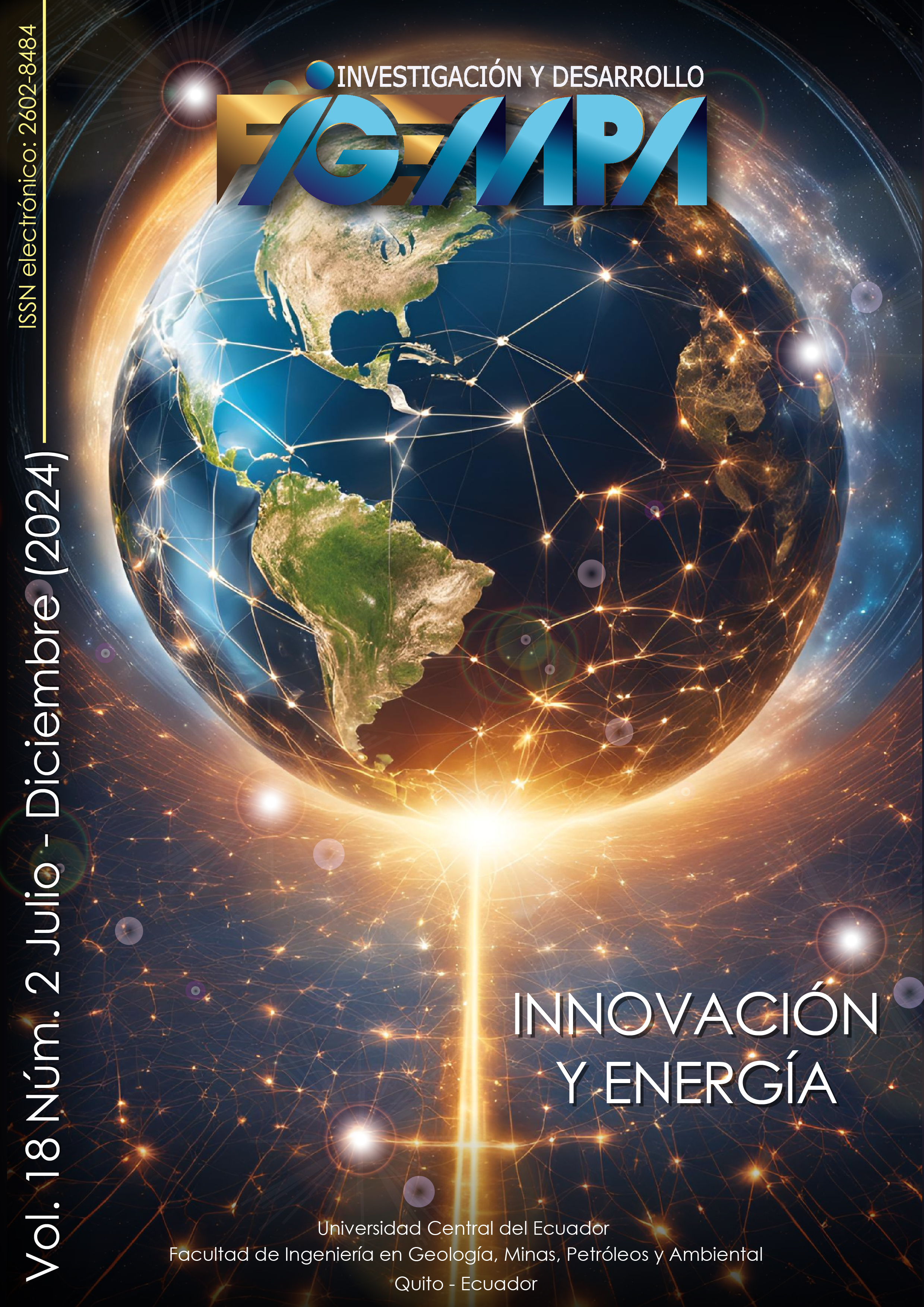Layers' system in mining projects
Main Article Content
Abstract
Geological mapping is a fundamental tool in the exploration and development of mineral resources. From regional to local scales, it is used in mining projects to identify the mineral resource, to model the deposit, to guide drilling, to plan mineral extraction, in mine design, and in the evaluation of risks and environmental impacts. In other words, it is present throughout the life cycle of the mining project. To understand the relationships that exist between the data obtained from various disciplines associated with geology, such as geophysics, geochemistry, petrography, structural geology, etc., it is appropriate that these be treated as a layers’ system. The importance of the use of this methodology is presented by means of bibliographic research. In particular, the Anaconda system, whose standardized procedures have allowed to obtain good results in the exploration or exploitation of minerals in Yerington-USA, La Costanaza-Spain, Ferrobamba-Peru, Guanajuato-Mexico, Imbabura-Ecuador, Atacama-Chile.
Downloads
Metrics
Article Details

This work is licensed under a Creative Commons Attribution 4.0 International License.
References
Abzalov, M. (2016) Applied Mining Geology. Springer International Publishing, doi: 10.1007/978-3-319-39264-6 DOI: https://doi.org/10.1007/978-3-319-39264-6
Antofagasta Minerals (2022) 02 Procedimiento Mapeo de Sondajes. Gerencia de Exploraciones. Disponible en: https://www.aminerals.cl/
ARCOM (2015) Reglamento de Calificación de Recursos y Reservas Mineras. Resolución 46. Agencia de Regulación y Control Minero.
Brimhall, G. H., y Vanegas, A. (2001) “Removing Science Workflow Barriers to Adoption of Digital Geological Mapping by Using the GeoMapper Universal Program and Visual User Interface”, Digital Mapping Techniques 601 Workshop Proceedings. U.S.G.S: Open-File Report, pp. 103-114.
Brimhall, G. H., Dilles, J. H., and Proffett, J. M. (2006) “The Role of Geologic Mapping in Mineral Exploration. Society of Economic Geologists”, Special Publication, 12, pp. 221-241. DOI: https://doi.org/10.5382/SP.12.11
CIM (2014) CIM Definition Standards for Mineral Resources & Mineral Reserves. Prepared by the CIM Standing Committee on Reserve Definitions. Canadian Institute of Mining, Metallurgy and Petroleum.
Einaudi, M. T. (1997) Mapping altered and mineralized rocks: An introduction to the Anaconda method. Stanford, California: Department of Geological and Environmental Sciences, Stanford University, 16 p.
Figueroa Galvis, N. Y. (2020) “Revisión sistemática de bibliografía con análisis de tendencias de investigación: unas pautas generales ejemplificadas”, Revista Investigación en Desarrollo y Gerencia Integral de Proyectos, 3(3), pp. 64–76, doi: 10.46659/26191830.v3.n%i.2020.169.
Garwin, S., Whistler, B., Ward, J., Vaca, S., Mather, N., Chand, M., Silva, J., Rosero, B., Cruz, A., Guachamin, A., Diaz Castro, C., Chafla, A., Mantilla, S., Aguilar, L., Easterday, C., Leighton, M., Aravena, A., Tapia, M., Vázquez, C., Miñano Tapia, E., Salas, P., Olivares, D., Costa, S., Beeson, J., Sheerin, K., Wallace, M., & McKie, C. (2022) “The Application of Geologic Mapping, Core Logging, and 3-D Geoscientific Data Integration in the Exploration and Resource Expansion of Porphyry Copper-(Gold) Deposits: Examples from Recent Discoveries in Ecuador and Chile”, SEG Newsletter, (131), pp. 13-24, doi: 10.5382/SEGnews.2022-131.fea-01 DOI: https://doi.org/10.5382/SEGnews.2022-131.fea-01
Genge, M. J. (2020) Geological Field Sketches and Illustrations: A Practical Guide. USA: Oxford University Press. DOI: https://doi.org/10.1093/oso/9780198835929.001.0001
Hitzman, M., Dilles, J., Barton, M. & Boland, M. (2009) “Mineral resource geology in academia: An impending crisis”, GSA Today, 19(8), pp. 26-28, doi: 10.1130/GSATG33GW.1 DOI: https://doi.org/10.1130/GSATG33GW.1
IIGE (2019) Estándares de Nomenclatura Estratigráfica, Simbolización y Abreviaturas para la Cartografía Geológica. Versión 2.0. Quito: Dirección de Transferencia Tecnológica e Incubación. Disponible en: https://www.geoenergia.gob.ec/wp-content/uploads/downloads/2020/05/15_resolucion_no_2019_082_de_abril_2020.pdf
Kretz, R. (1983) “Symbols for Rock-Forming Minerals”, American Mineralogist, 68, pp. 277-279.
Llerena, G. M., Guerrero, B., & Espinosa, D. (2016) “Estudio de exploración inicial: Proyecto geológico-minero Guanajuato México”, FIGEMPA: Investigación y Desarrollo, 2(2), pp. 7–12, doi: 10.29166/revfig.v1i2.861 DOI: https://doi.org/10.29166/revfig.v1i2.861
Llerena, G. M., Guerrero, B., & Macías, J. (2017) “Estudio de exploración avanzada: Proyecto Geológico-minero Guanajuato México”, FIGEMPA: Investigación y Desarrollo, 3(1), pp. 15–19, doi: 10.29166/revfig.v1i1.51 DOI: https://doi.org/10.29166/revfig.v1i1.51
Llerena, G. M. (2023) Sistema de Folios. Universidad Central del Ecuador, Inédito.
Marjoribanks, R. (2010) Geological Methods in Mineral Exploration and Mining. Springer Berlin Heidelberg, doi: 10.1007/978-3-540-74375-0 DOI: https://doi.org/10.1007/978-3-540-74375-0
Mogk, D. (2012) Earth and Mind: the Blog, Mining and the Future. Disponible en: https://serc.carleton.edu/earthandmind/posts/mining_future.html
Nickless, E., Ali, S., Arndt, N., Brown, G., Demetriades, A., Durrheim, R., Enriquez, M., Giurco, D., Kinnaird, J., Littleboy, A., Masotti, F., Meinert, L., Nyanganyura, D., Oberhänsli, R., Salem, J., Schneider, G., & Yakovleva., N. (2015) Resourcing Future Generations: A Global Effort to Meet the World’s Future Needs Head-on. International Union of Geological Sciences. Disponible en: https://www.researchgate.net/publication/281068953_Resourcing_Future_Generations_A_Global_Effort_to_Meet_the_World's_Future_Needs_Head-On
NRGI (2015) The Resource Curse. The Political and Economic Challenges of Natural Resource Wealth. Natural Resource Governance Institute.
Nystrom, E. (2011) “Underground Mine Maps and the Development of the Butte System at the Turn of the 20th Century”, IA: The Journal of the Society for Industrial Archeology, 37(1-2), pp. 97-113. Disponible en: https://www.jstor.org/stable/23757911
Rivas, S. (2015) Mapping and mineral characterization of the phosphate ore ‘La Costanaza’, Logrosán (Cáceres). Tesis de Maestría. Universidad Complutense de Madrid.
Singh, S., Sharma, G. D., Radulescu, M., Balsalobre-Lorente, D., & Bansal, P. (2023) “Do natural resources impact economic growth: An investigation of P5+1 countries under sustainable management”, Geoscience Frontiers, 15(3), 101595, doi: 10.1016/j.gsf.2023.101595 DOI: https://doi.org/10.1016/j.gsf.2023.101595
Smith, Q. E. (2016) “Vein Density, Orientation, Paragenesis and Wall Rock Alteration of the Ferrobamba Cu-Mo Porphyry Deposit, Apurimac Region, Peru”, XVIII Peruvian Geological Congress. Pontifical Catholic University of Peru 16-19 octubre 2016. Lima: Sociedad Geológica del Perú, 5 p.
USGS (2006) FGDC Digital Cartography Standard for Geologic Map Symbolization. Geologic Data Subcommittee. Federal Geographic Data Committee. United States Geological Survey.
Wang, W., Xue, C., Zhao, J., Yuan, C., & Tang, J. (2024) “Machine learning-based field geological mapping: A new exploration of geological survey data acquisition strategy”, Ore Geology Reviews, 166, 105959, doi: 10.1016/j.oregeorev.2024.105959 DOI: https://doi.org/10.1016/j.oregeorev.2024.105959

